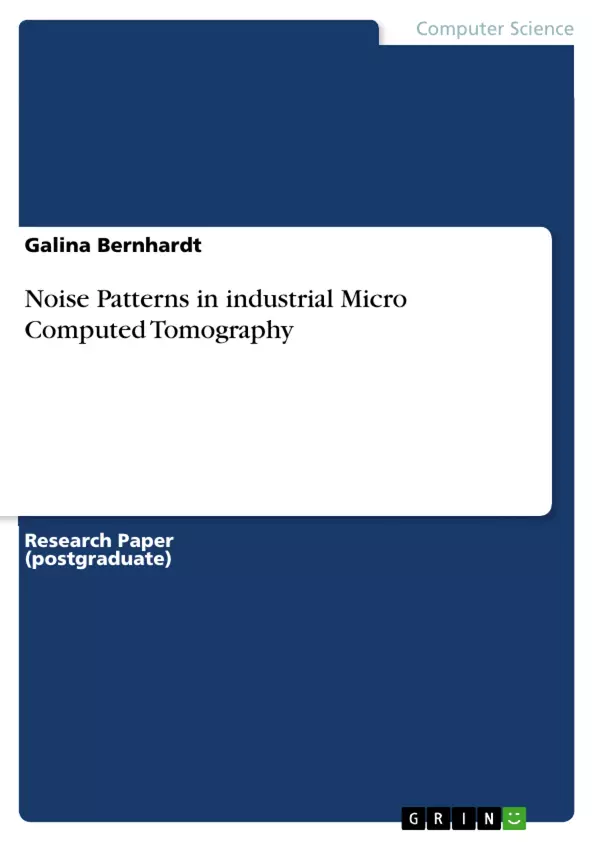Computer Tomography (CT) systems are used to produced images that are finding increasing use in medicine and mineralogy as in the Natural History Museum. In order to maximise the system performance, the images or scans, must have high quality.
Ideally, the physical CT system should preserve the image quality. However, in reality,various physical processes degrade the quality of these images, producing noise and artefacts.
The goal of this work is to understand the noise and artefacts in high-resolution imaging application of micro computer tomography (micro-CT). The project specifically lookedat determining:
I. How micro-CT scan parameters be optimised to reduce noise, and
II. Which of the many commonly used noise reduction algorithms produce the best results, and
III. How current and exposure effect each other.
Experiments were carried out to obtain the raw data – images / scans for the study. Theoretical models were then implemented on the raw data to analyse and better understand the noise and artefacts in the images.
This work provides a better understanding of both the fundamental performance (i.e. image quality) of the micro-CT system, and the assessment of user-defined parameters that could be used to optimise the performance of the micro-CT systems.
These contributions will not only save time, money and resources, which will ultimately lead to better image quality (greater accuracy)
Inhaltsverzeichnis (Table of Contents)
- Introduction
- The Natural History Museum London (NHM)
- The beginning of the British Museum (NHM London)
- NHM in the 21st Century
- Computed Tomography(CT) - Introduction
- Industrial Computed Tomography
- Micro-CT
- Noise/Artefacts
- Artefacts
- Noise
- Filters
- Reasons for using a digital filter
- High-pass Filters
- Low-pass Filters
- Kalman Stack Filter
- Gaussian blur Filter
- Kuwahara Filter
- Project Assignment: Analysing noise pattern in Micro-CT
- Materials and Methods
- Metris X-Tek HMX ST 225 CT System
- Phantom Design
- ImageJ plug-in Code
- Description of project objectives: Part I, Part II and Part III
- Part I: How do scan parameters affect noise?
- Part II: What is the best type of noise reduction algorithm for CT?
- Part III: How current, exposure and noise affect each other?
- Summary and Analysis
- Insight from experiments
- Analysing pattern of the noise variation
- Optmising parameters for noise reduction
- Analysing current vs. exposure effect
- Conclusion and future work
- Insights from post-processing
- Suggestions for future work
- Appendix A
- How to use the Plug-in
- References
Zielsetzung und Themenschwerpunkte (Objectives and Key Themes)
This work aims to understand noise and artefacts in high-resolution imaging applications of micro computer tomography (micro-CT). The project specifically investigated the following questions:
- How micro-CT scan parameters can be optimised to reduce noise.
- Which noise reduction algorithms produce the best results for CT.
- The relationship between current, exposure, and noise in micro-CT systems.
- The fundamental performance (i.e. image quality) of the micro-CT system.
- The assessment of user-defined parameters that could be used to optimise the performance of the micro-CT systems.
Zusammenfassung der Kapitel (Chapter Summaries)
- Introduction: This chapter provides background information on the Natural History Museum in London, including its history and current state. It then introduces Computer Tomography (CT), focusing on the principles of industrial CT and Micro-CT. The chapter discusses noise and artefacts, explaining their differences and the challenges they present in CT operations. Finally, it covers fundamental principles of low and high pass filters in digital signal processing.
- Project Assignment: Analysing noise pattern in Micro-CT: This chapter describes the materials and methods used in the project. It discusses the Metris X-Tek HMX ST 225 CT System used for the experiments, the phantom design, and the ImageJ plug-in code used for image processing. The chapter then details the three main objectives of the project and the specific methods used to investigate each objective.
- Summary and Analysis: This chapter presents the insights gained from the experiments. It analyzes the pattern of noise variation, discusses the optimization of parameters for noise reduction, and examines the relationship between current and exposure effects on noise.
Schlüsselwörter (Keywords)
This work focuses on noise and artefacts in micro-CT, investigating the relationship between scan parameters, noise reduction algorithms, current, exposure, and image quality. The project utilizes a high-resolution micro-CT system for data acquisition and employs ImageJ and its plug-in for analyzing the noise patterns. The study investigates the fundamental performance of the micro-CT system and explores user-defined parameters that can be optimized for improved image quality.
- Citar trabajo
- Galina Bernhardt (Autor), 2010, Noise Patterns in industrial Micro Computed Tomography, Múnich, GRIN Verlag, https://www.grin.com/document/165584



